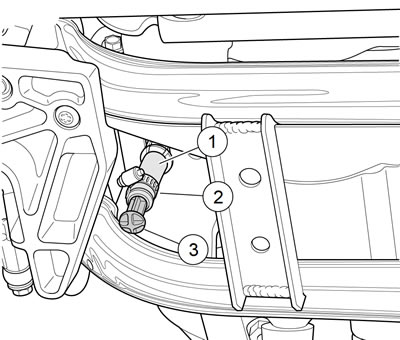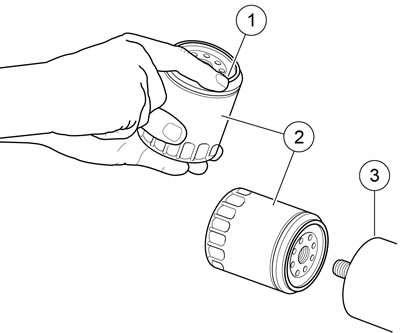| PART NUMBER | TOOL NAME |
| HD-42311 | HARLEY-DAVIDSON OIL FILTER WRENCH |
| HD-44067-A | HARLEY-DAVIDSON OIL FILTER WRENCH |
| FASTENER | TORQUE VALUE | |
| Oil drain hose worm clamp | 6-10 in·lbs | 0.7-1.1 Nm |
Notice: Do not switch lubricant brands indiscriminately because some lubricants interact chemically when mixed. Use of inferior lubricants can damage the engine.
Completely drain oil tank of used oil at scheduled service intervals. Refill with fresh oil. Refer to Table 1-4.
Notes:
- Change oil at specified intervals in normal service at warm or moderate temperatures.
- Change engine oil at shorter intervals in cold weather or in severe operating conditions. See 1.3 FUEL AND OIL, Winter Lubrication.
- Change engine oil at shorter intervals if ridden extremely
- hard, used in competition, or driven on dusty roads.
- Always change oil filter when changing engine oil.
Warning! Be sure that no lubricants or fluids get on tires, wheels or brakes when changing fluid. Traction can be adversely affected, which could result in loss of control of the motorcycle and death or serious injury.
Draining oil tank
1. Run engine until engine oil has reached normal operating temperature.
2. Remove dipstick from oil tank. Oil will drain faster when the dipstick is removed.
3. See Figure 1-4. Place a suitable container directly under the drain hose (1) at the bottom rear of the engine crankcase. The container must be able to hold approximately 3.0 qt (2.8 L).

Figure 1-4. Oil Tank Drain Hose: 1. Oil tank drain hose; 2. Worm drive clamp; 3. Drain plug
4. Loosen worm drive clamp (2). Pull drain plug (3) from end of drain hose. Completely drain engine oil from oil tank. Drain engine crankcase only if needed.
5. Install drain plug into end of drain hose. Tighten worm drive clamp to 6-10 in·lbs (0.7-1.1 Nm).
Removing oil filter
1. Place a drain pan beneath front of engine crankcase.
Notice: Use Harley-Davidson oil filter wrench for filter removal. This tool can prevent damage to crankshaft position sensor and/or sensor cable.
2. See Figure 1-5 and Figure 1-6. Remove oil filter using HARLEY-DAVIDSON OIL FILTER WRENCH (Part No. HD-42311) or HARLEY-DAVIDSON OIL FILTER WRENCH (Part No. HD-44067-A). Turn oil filter counterclockwise to remove from filter mount.

Figure 1-5. Oil Filter Wrenches
3. Drain oil filter into drain pan. Discard oil filter.
4. Clean any oil spills off crankcase and frame.
Note. Dispose of oil and oil filter in accordance with local regulations.

Figure 1-6. Oil Filter: 1. Oil filter mount; 2. Oil filter
Installing oil filter
Note. Minimize the time required for buildup of oil pressure when engine is first started. Partially fill oil filter before installation.
1. Pour about 4 fl oz (120 mL) of fresh, clean engine oil into new oil filter. Allow time for oil to soak into filter element.
2. See Figure 1-7. Wipe filter gasket contact surface of oil filter mount with a clean cloth. Surface should be smooth and free of any debris or old gasket material.

Figure 1-7. Applying Thin Oil Film: 1. Thin film of oil ONLY; 2. Oil filter; 3. Mounting plate
3. Apply a thin film of oil to gasket contact surface on crankcase (3) and gasket surface of new oil filter.
Note. Do not use oil filter wrench to install new oil filter.
4. Install new oil filter. Screw filter clockwise onto adapter until gasket contacts the filter mount surface. Then hand tighten an additional 1/2-3/4-turn to secure the oil filter.
Refilling oil tank
Notice: Do not overfill oil. Doing so can result in oil carryover to the air cleaner leading to equipment damage and/or equipment malfunction.
Note. Do not overfill the oil tank. The oil tank has a built-in pressure relief valve. If the oil tank is overfilled, excessive pressure is created in the oil tank. The pressure relief valve will open to relieve the pressure and prevent damage to the oil tank. Excessive oil due to overfilling will also be forced out the pressure relief valve when it opens.
1. Refer to Table 1-2. Always use the proper grade of oil for the lowest expected air temperature before the next regularly scheduled oil change. Pour 2.0 qt (1.9 L) of oil into engine oil tank.
2. Install dipstick in oil tank. Verify cap is fully seated.
3. See Figure 1-8. Start engine. Verify that oil pressure signal lamp turns off when engine speed is 1000 rpm or above. Turn engine off.

Figure 1-8. Oil Pressure Indicator
4. Check for oil leaks at oil filter and oil tank drain hose. Perform oil level hot check.
